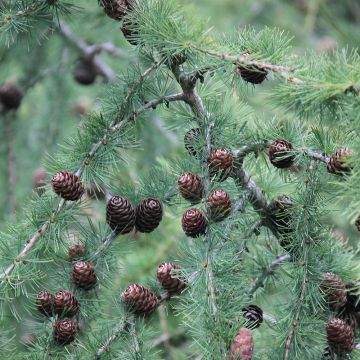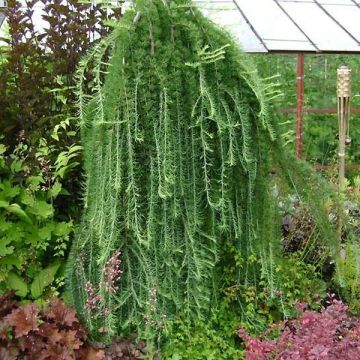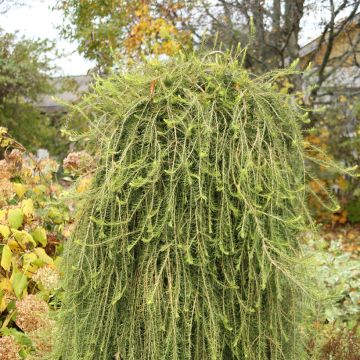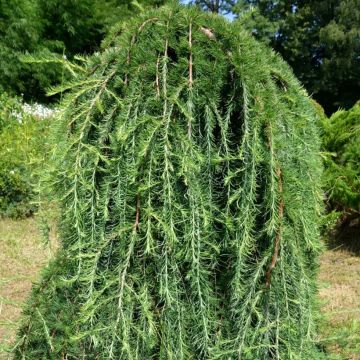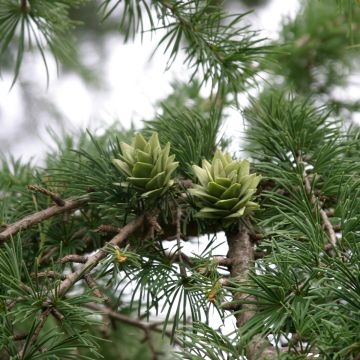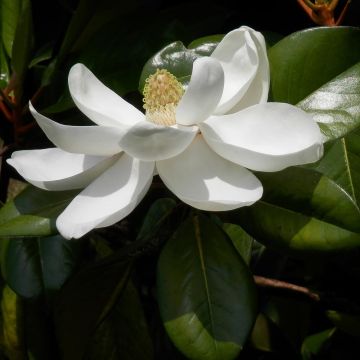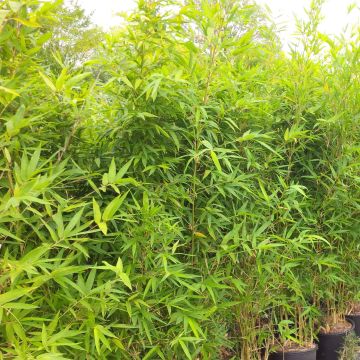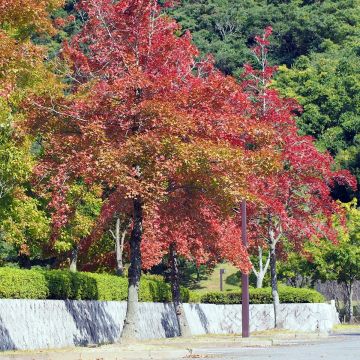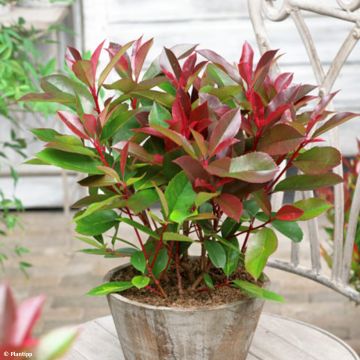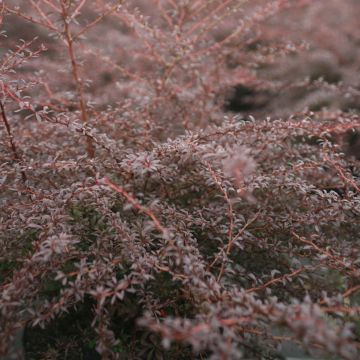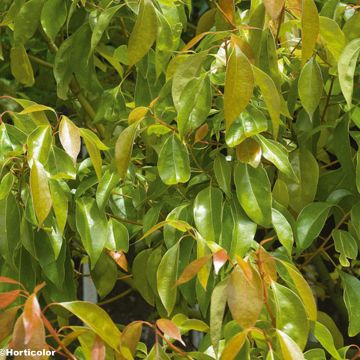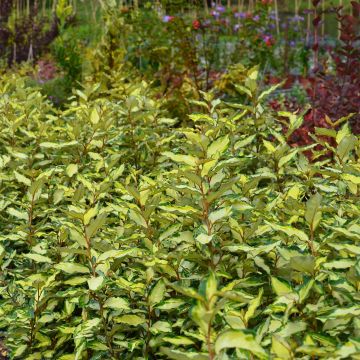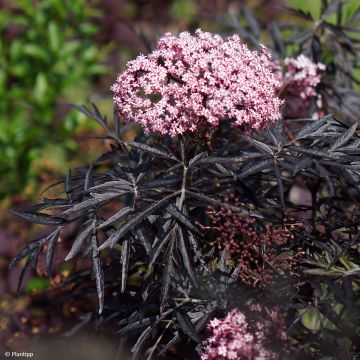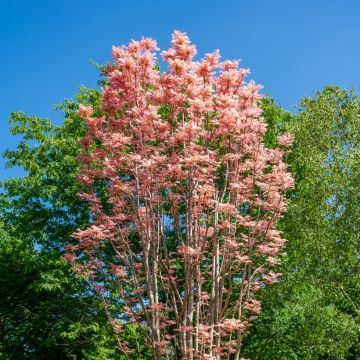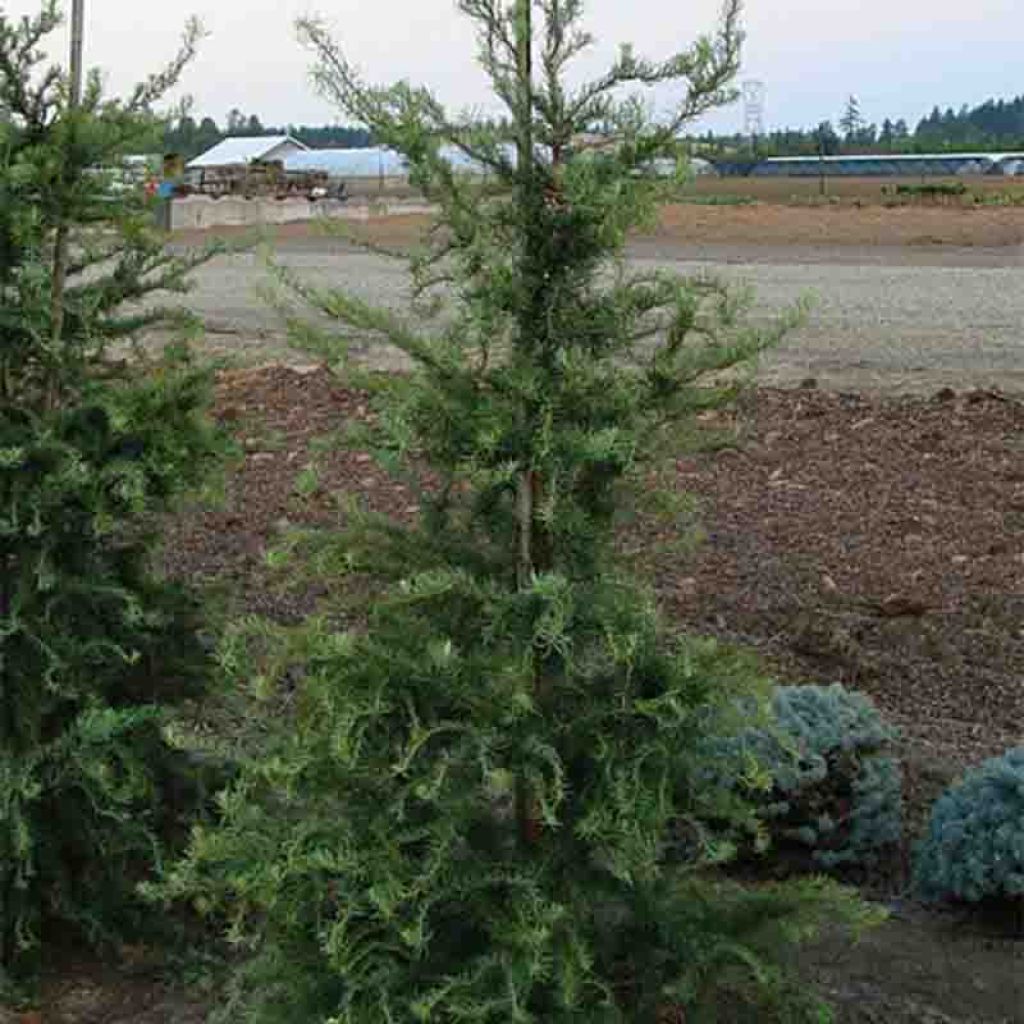

Larix kaempferi Diana - Larch
Larix kaempferi Diana - Larch
Larix kaempferi Diana
Japanese Larch, Kaempfer's Larch
Parcel and plants great, nothing negative to say, I recommend, thanks.
jacques, 12/12/2020
Why not try an alternative variety in stock?
View all →This plant carries a 24 months recovery warranty
More information
We guarantee the quality of our plants for a full growing cycle, and will replace at our expense any plant that fails to recover under normal climatic and planting conditions.
Oversize package: home delivery by special carrier from €6.90 per order..
Express home delivery from €8.90.
Does this plant fit my garden?
Set up your Plantfit profile →
Description
Larix kaempferi 'Diana' contorta, also known as contorted Japanese larch, is a deciduous conifer with a narrow and twisted pyramidal habit, adorned with fragrant and soft-to-the-touch foliage. Its twisted needles are a tender green with a bluish hue. They turn a flamboyant golden yellow in autumn. It is a small tree that naturally stands out when planted as a specimen. Very hardy. It prefers light, moist, non-calcareous soil, as well as a sunny exposure.
The Japanese larch, Larix kaempferi, also known as Larix leptolepis, is a large Japanese conifer with a conical habit and deciduous foliage. It is native to the mountains of the Hondo Island, at altitudes ranging from 1300 to 2900m (4265 to 9514ft), but it adapts very well to lowland cultivation in a rather cool oceanic climate. It belongs to the Pinaceae family, like pines, firs, and spruces. It is a very close relative of the European Larix decidua.
The 'Diana' variety forms a small tree with a narrow and pyramidal habit, reaching 2.25m (7ft) in height and 1.2m (4ft) in width after 10 years. Its growth is rather slow but faster than that of the European larch. At maturity, it can reach 6m (20ft) in height and 2.5m (8ft) in width, depending on growing conditions. This variety stands out for its trunk, branches, twigs, and needles which exhibit a completely unique twisted appearance. Its gracefully twisted, thick, and layered branches give it a very sculptural silhouette in winter. In spring, the twigs are adorned with tender water-green needle foliage, arranged in rosettes on the short twigs or individually on the long twigs. They later turn a magnificent golden yellow colour in autumn. They are grouped in tufts composed of 35 to 40 needles. The female cones are cylindrical and reddish, turning purple after fertilisation, and then light brown when ripe. The male cones, on the other hand, bear small round and yellow pollen sacs. A thin reddish-brown or orange-red bark covers the old branches. The bark cracks into scales with age.
The 'Diana' larch is a magnificent and unique conifer that is not demanding. It is easy to grow as a specimen, as long as the soil remains fairly moist and it is placed in a sunny position. It also blends well with geometric lines and masonry structures. The true sculptural qualities of conifers naturally come to the fore in the design of a contemporary garden, which favours the aesthetics of shapes, silhouettes, and textures over the fleeting appearance of blooms. These plants provide long-lasting structure to a flower bed. They can mark pathways and border patios, easily replacing the strong presence of trimmed boxwood. They can be paired with unruly grasses and heathers, whose temperament is highly complementary. The key is to play with volumes and colours.
Tips: Water regularly during the first two years and in case of prolonged drought. It can tolerate occasional dry soil in a cool climate, but this conifer will disappoint in a climate with dry and hot summers.
Report an error about the product description
Larix kaempferi Diana - Larch in pictures
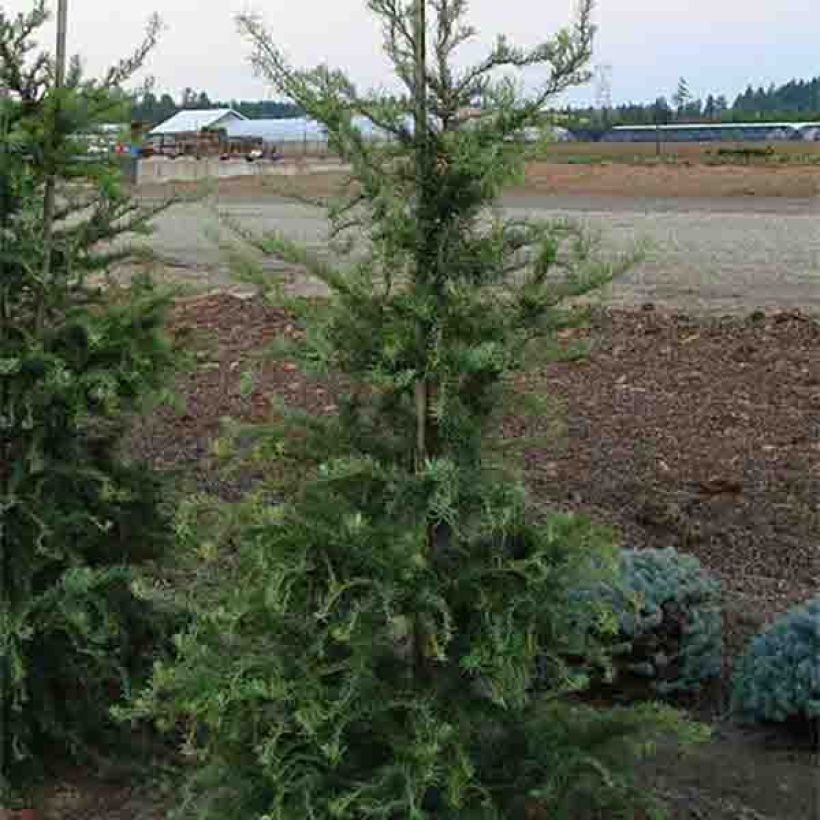

Plant habit
Flowering
Foliage
Botanical data
Larix
kaempferi
Diana
Pinaceae
Japanese Larch, Kaempfer's Larch
Cultivar or hybrid
Other Larix - Larch
Planting and care
Larix kaempferi 'Diana' is a plant from cool, mountainous climates. It fears arid situations. Plant from September to November in well-drained soil that retains moisture. It will tolerate poor soil, but without excess limestone. Plant in a sunny or semi-shaded location. A mixture of coarse sand, ericaceous soil, and compost added to the garden soil will work very well. If your soil is too heavy, plant your bush in a mound and mulch it with gravel. Water regularly during the first two years, and in case of prolonged drought. Soak the root balls well before planting. This very hardy conifer fears heavy, waterlogged soils. Pruning is not necessary, but this conifer can be pruned to maintain or accentuate its original habit. Pruning should be done in February-March.
Planting period
Intended location
Care
-
, onOrder confirmed
Reply from on Promesse de fleurs
Striking foliage shrubs
Haven't found what you were looking for?
Hardiness is the lowest winter temperature a plant can endure without suffering serious damage or even dying. However, hardiness is affected by location (a sheltered area, such as a patio), protection (winter cover) and soil type (hardiness is improved by well-drained soil).

Photo Sharing Terms & Conditions
In order to encourage gardeners to interact and share their experiences, Promesse de fleurs offers various media enabling content to be uploaded onto its Site - in particular via the ‘Photo sharing’ module.
The User agrees to refrain from:
- Posting any content that is illegal, prejudicial, insulting, racist, inciteful to hatred, revisionist, contrary to public decency, that infringes on privacy or on the privacy rights of third parties, in particular the publicity rights of persons and goods, intellectual property rights, or the right to privacy.
- Submitting content on behalf of a third party;
- Impersonate the identity of a third party and/or publish any personal information about a third party;
In general, the User undertakes to refrain from any unethical behaviour.
All Content (in particular text, comments, files, images, photos, videos, creative works, etc.), which may be subject to property or intellectual property rights, image or other private rights, shall remain the property of the User, subject to the limited rights granted by the terms of the licence granted by Promesse de fleurs as stated below. Users are at liberty to publish or not to publish such Content on the Site, notably via the ‘Photo Sharing’ facility, and accept that this Content shall be made public and freely accessible, notably on the Internet.
Users further acknowledge, undertake to have ,and guarantee that they hold all necessary rights and permissions to publish such material on the Site, in particular with regard to the legislation in force pertaining to any privacy, property, intellectual property, image, or contractual rights, or rights of any other nature. By publishing such Content on the Site, Users acknowledge accepting full liability as publishers of the Content within the meaning of the law, and grant Promesse de fleurs, free of charge, an inclusive, worldwide licence for the said Content for the entire duration of its publication, including all reproduction, representation, up/downloading, displaying, performing, transmission, and storage rights.
Users also grant permission for their name to be linked to the Content and accept that this link may not always be made available.
By engaging in posting material, Users consent to their Content becoming automatically accessible on the Internet, in particular on other sites and/or blogs and/or web pages of the Promesse de fleurs site, including in particular social pages and the Promesse de fleurs catalogue.
Users may secure the removal of entrusted content free of charge by issuing a simple request via our contact form.
The flowering period indicated on our website applies to countries and regions located in USDA zone 8 (France, the United Kingdom, Ireland, the Netherlands, etc.)
It will vary according to where you live:
- In zones 9 to 10 (Italy, Spain, Greece, etc.), flowering will occur about 2 to 4 weeks earlier.
- In zones 6 to 7 (Germany, Poland, Slovenia, and lower mountainous regions), flowering will be delayed by 2 to 3 weeks.
- In zone 5 (Central Europe, Scandinavia), blooming will be delayed by 3 to 5 weeks.
In temperate climates, pruning of spring-flowering shrubs (forsythia, spireas, etc.) should be done just after flowering.
Pruning of summer-flowering shrubs (Indian Lilac, Perovskia, etc.) can be done in winter or spring.
In cold regions as well as with frost-sensitive plants, avoid pruning too early when severe frosts may still occur.
The planting period indicated on our website applies to countries and regions located in USDA zone 8 (France, United Kingdom, Ireland, Netherlands).
It will vary according to where you live:
- In Mediterranean zones (Marseille, Madrid, Milan, etc.), autumn and winter are the best planting periods.
- In continental zones (Strasbourg, Munich, Vienna, etc.), delay planting by 2 to 3 weeks in spring and bring it forward by 2 to 4 weeks in autumn.
- In mountainous regions (the Alps, Pyrenees, Carpathians, etc.), it is best to plant in late spring (May-June) or late summer (August-September).
The harvesting period indicated on our website applies to countries and regions in USDA zone 8 (France, England, Ireland, the Netherlands).
In colder areas (Scandinavia, Poland, Austria...) fruit and vegetable harvests are likely to be delayed by 3-4 weeks.
In warmer areas (Italy, Spain, Greece, etc.), harvesting will probably take place earlier, depending on weather conditions.
The sowing periods indicated on our website apply to countries and regions within USDA Zone 8 (France, UK, Ireland, Netherlands).
In colder areas (Scandinavia, Poland, Austria...), delay any outdoor sowing by 3-4 weeks, or sow under glass.
In warmer climes (Italy, Spain, Greece, etc.), bring outdoor sowing forward by a few weeks.

































